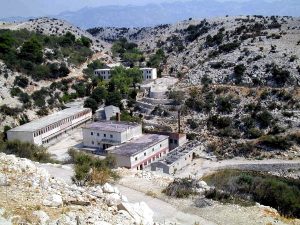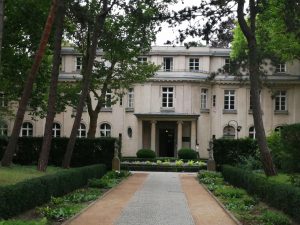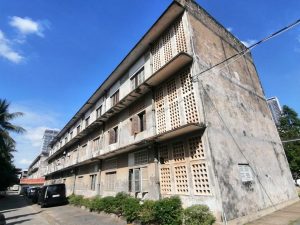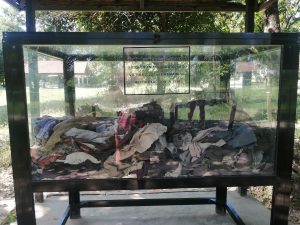
In three different parts of the Balkan Peninsula, one can find the remnants of island prisons.
Perhaps the best-known prison island is Goli Otok (naked island, pictured) off the Croatian coast. This island hosts a prison that was established in the early days of Socialist Yugoslavia.
The island had no other inhabitants. It has been used a prison previously, during the First World War, Austrians kept captured Russian prisoner of war there.
Following the dramatic Tito-Stalin ‘split’ of 1948, a prison camp was established for political prisoner suspected of loyalty to the USSR. However, a broad category of political prisoners were incarcerated there; veterans of the Spanish civil War, even of the October Revolution. Some were losers in power struggles within the Yugoslav Communist Party, and were feared as potential rivals by Tito.
The camp was in use from 1949 until 1956, when tensions with the USSR eased. The camp was thereafter used as an ordinary prison, and closed in the 1980s.
There was a smaller prison island nearby called Sveti Grgur (Saint Gregory), which housed female prisoners.
In a grim way, the Goli Otok camp was an exercise in Tito’s vaunted workers’ self-management (radničko samoupravljanje). In this particular case, it meant that the first prisoners on the island had to build the facilities – barracks and workshops – but also the inmates themselves would run the camp, though supervised by exterior guards. This led to a brutal hierarchy with the camp. The supposed idea behind the camp was ideological re-education, and the collective beating that greeted new arrivals (‘running the line’) was to impose conformity. The prisoners that cooperated rose in rank.
The term ‘camp’ (logor) was forbidden, as it would associate the site with Nazi or Soviet camps, which it, of course, resembled.
The camp’s existence was kept a secret for many years. Secretive too is whose idea it was to establish it. According to historian Martin Previšić, who has published a book on the history of the camp, it seems that no one individual can be identified. Its location was surely a factor; there was both a port and a railway close by on the mainland.
Goli Otok is now a tourist destination – day trippers on the coast can organize boat trips to see the “Croatian Alcatraz”. Unlike the famous site off San Francisco, nobody – despite rumors that cling to all prisons – ever escaped from the naked island.
By Brendan Humphreys
A Balkan Archipelago? Part 2
Another island prison in the Balkans in not located at sea. Rather, Belene is on an island in the Danube, the island belongs to Bulgaria, but the river constitutes the actual border at that location, the north bank is Romania.
(A lost Danubian world – an interface of crumbling Habsburg and Ottoman empires – is beautifully captured in Elias Canetti’s memoir of childhood, The Tongue Set Free.[1] Canetti was from a Ladino-speaking Sephardic family from Ruse/ Ruschuk, a town that was home to Turks, Greeks, Armenians, Roma, Romanians, Bulgarians, Russians and their various languages.)
This island was the site of a notorious communist prison, which was used mostly in the repressive years of 1949–1959, when for example, several religious figures were imprisoned there.
After years of disuse, it was re-opened in the 1980s, when Bulgaria underwent a brutal assimilation program of the country’s Muslim population – the Turkish minority and the Pomaks (Slavonic Muslims). This so called ‘rebirth process’ (vazroditelen protses) was a manifestation of nativist populism that was against the ideology of international socialism. Later, in 1989, the year of miracles in Eastern Europe, the Bulgarian government suddenly expelled 360,000 Turks and Pomaks, driving them over the border into Turkey. This later episode was called the Big Excursion (goliamata ekskurziia) and was an exercise in ‘ethnic cleansing’ – a term soon to enter the world’s lexicon due to the conflict across the Yugoslav border.
This understudied episode has finally been given a book-length treatment in Tomasz Kamusella’s Ethnic Cleansing During the Cold War, The Forgotten 1989 Expulsion of the Turks From Communist Bulgaria[2].
As for the Belene camp, as Kamusella states, “In the good Stalinist manner, with snow and rain falling on their heads, the first contingent of inmates actually had to re-build the camp for themselves.”[3] He argues that statistics were falsified and that many people who officially died by suicide or illness during the 1980s, were in fact victims of beatings and summary executions.
There is still a prison in operation on Belene Island – the island also hosts a nature reserve.
Epilogue
The mass expulsion was seen as an immediate disaster by the Bulgarian state; not on humane grounds, rather they belatedly realized that they had lost a vital workforce. After only months, the expelled started to move back to Bulgaria. Subsequent Bulgarian regimes have apologized for the episode.
[1] Granta Books, 1979 (1977).
[2] Routledge Studies in Modern European History, London, 2019.
[3] Ibid., 42.
‘You can’t blame buildings’ A manor house with a dark past

The castle of the Keglević in Lobor, Croatia (pictured) , is some three hundred years old. It was the manor house of a prominent family, but was abandoned by the early 20th century. The Keglević family – of Croatian Hungarian nobility – had some association with Vienna’s musical culture in the era of Beethoven and Schubert (one family member has a Beethoven sonata dedicated to her, another wrote music published by Diabelli).
According to its website, the castle was used as hospital from 1920 until 1923, being then staffed by Russian doctors, who had been captured at the Eastern front in the First Word War.
Today, with new annexes added, it is a home for mentally ill adults. Successfully repurposed, as one likes to see with older buildings, the website of the home give a brief mention to the history of the castle. In the 1930s, the building was run by a religious charity, and was used as a poorhouse (ubožnicu). During the Second World War, the website tells us, it “continued its function”.
Unfortunately, its function during the Second World War was radically different. The castle was converted into an Ustasa concentration camp, one specifically for Jewish and Serbian women and children.
The camp was run by two Volksdeutsche brothers Karl and Valdemar Heger – apparently watchmakers by profession – and most of the guards were also Volksdeutsche gendarmes. “Sadistic treatment, including rape, was meted out to the women and children.[1] According to the American Holocaust museum;
“Of the approximately 2,000 women and children who were imprisoned at one time in the camp, probably 200 died. Most died from typhoid, and others from illness caused by the depleted food supplies, mistreatment by guards, and the indescribably unhygienic conditions, due principally to the extreme overcrowding in the barracks, which were completely lacking in sanitation facilities.”[2]
The camp and its function was not a secret in its day; on the contrary, the Jewish community of Zagreb sent materials to the prisoners (typically stolen by the guards) and even had a representative visit the premises. The camp operated in 1941 and 1942. An auxiliary camp was built to ease overcrowding. Some of the prisoners were sent on to the notorious Jasenovac complex; other children were transferred to other camps or hospitals, which may have saved their lives. In August 1942, the remaining women and children were given over to Nazi custody, and sent to Auschwitz. None survived.
Should there not be some sign of acknowledgment by the present administrators of the building, which now has a positive, caring function?
A similar issue was raised, in a better know case, by the continued use of the spa hotel Vilina Vlas in Višegrad, Bosnia. The hotel was a site of multiple atrocities – most especially the rape and murder of women – during the war of 1992-95. The hotel still functions as a ‘rehabilition center’ and there is no acknowledgment, by its custodians, of the horrors that took place there.
Bilal Memišević is the only Muslim member of the regional assemble, indeed, one of the few Muslims remaining in Višegrad. In 1991, it was a two/thirds Muslim majority town, but post-Dayton it is located in the Republika Srbska. Both of his parents died in the war. He wishes acknowledgment for the suffering of his family and community, but would not want the Vilina Vlas closed down. He nonetheless considers it “a terrible kind of place”. “Rationally, you can’t blame buildings. It’s the ideology that needs to be changed. If you say we have to destroy the spa, by that logic you have to destroy half of Bosnia.”[3]
True, the town is known to readers all over the world as the site of Ivo Andric’s The Bridge of the Drina, where the history of three centuries happens around the immobile bridge as the river flows like time beneath it.
It is a dilemma. Should a hotel actually broadcast the fact that thirty years ago, it was as place of systematic rape and murder? (“How was your stay Madame? Was your bed comfortable?”)
It is somewhat easier for a psychological hospital to admit that eighty years ago it was a site of crimes against humanity, (although it has not done so). Time is a factor certainly; so many victims and perpetrators of Bosnia’s tragedy are still alive, in trauma or in denial.
Epilogue
Never tried for their crimes, the watchmaking bothers Heger died in 1996 and 2007 respectively, in the sleepy Austrian towns of Mariazell and Tillmitsch.
[1] Francine Friedman, Bread for Salt, the Jews of Bosnia and Hertzegovina, 467
[2] Lohse, Alexandra, ‘Croatia’ in Encyclopedia of Camps and Ghettos, American Holocaust Museum, Washington
[3] ”Back on the tourist trail: the hotel where women were raped and tortured”, Emma Graham-Harrison, Observer, 28 Jan, 2018
On the innocence of buildings


These photos were taken at the elegant villa that became notorious for being the site where the arch crime of the 20th century was planned. The crime was the ‘final solution of the Jewish question’ and the address, Am Großen Wannsee 56-58, Wannsee, a comfortable suburb of Berlin. The conference took place on January 20th, 1942. Then, as now, this is a very attractive lakeside setting, surrounded by sailing clubs and gardens.
It might not be strictly correct to say the Holocaust was planned at Wannsee, rather the conference that took place here was an effort to get the cooperation of various Staatssekretäre (undersecretaries of state) in the destruction of Europe’s Jews. The conference was convened by Reinhard Heydrich (1904-1942), and the effective secretary was Adolf Eichmann (1906-1962). Both of these notorious figures were members of the SS, but they realized that they needed senior civil servants, who were not even members of the Nazi party, to acquiesce in forced deportation and mass murder.
To quote Hannah Arendt: ‘As Eichmann put it, Heydrich “expected the greatest difficulties.” Well, he could not have been more wrong.’ The conference only lasted an hours and a half, and despite some legalist wrangling, there was not dissent to the aims presented.
Following the war, the building was used as a school. Efforts to transfer into a Holocaust memorial or museum were not realized until 1992, the 50th anniversary of the conference. The current Wannsee Conference House Memorial is an informative site, with no attempt to disguise the horrible purpose for which it was used in January 1942, even if only for some 90 minutes.
With is elegance, classical decoration, and view of the lake, it is almost impossible to reconcile with its dark past.
Epilogue
Heydrich was assassinated in Prague in June 1942; terrible vengeance was taken by the destruction of the towns of Lidice and Ležáky, and the mass murder of their populations.
In 1960, Israeli agents captured Eichmann in Argentina and he was later put on trial in Jerusalem. He was found guilty of 15 charges including crimes against humanity, war crimes, and crimes against the Jewish people. He was executed in June 1962.
Genocide sites in Cambodia

Another building – a far less elegant one – that was once a school is in the compound known as S21 in Phnom Penh. From 1975-1979 this was a Khmer Rouge prison and interrogation center (pictured above).
I had read about, and seen images of the ‘prison’ before, but visiting in person made a powerful impression. Having seen a black and white photo of an interrogation room, I assumed that this was ‘the’ torture chamber of the prison. The room was bare; a tiled floor (it was previously a classroom), barred window, and a metal bed with cuffs for the hands and feet of the prisoner (pictured below).
In fact, many of the rooms of the site are torture chambers, each identical to this, some with two beds. (There are also some tiny individual cells, crudely built of bricks). In some interrogation rooms, there is a photograph of the prisoner found there when the building was liberated by the Vietnamese who invaded Cambodia in 1978.

All prisoners who arrived here were photographed, and their images are on display in the museum, some identified by name, many not. An estimated 20,000 unfortunate souls were confined and abused in this compound, it is calculated only a handful of prisoners survived.
Although some executed prisoners were first buried in the compound, later internees were taken to a special site to be killed. This was Choeung Ek, now the Choeung Ek Genocide Museum, was one of the notorious Killing Fields of the Khmer Rouge regime. There were some 300 killing sites throughout Cambodia.
Choeung Ek was an execution site and burial site. Located in an orchard on the outskirts of Phnom Penh, it is now a well-organized memorial. The audio tour is horrifying and moving, but like in S21, the text of the voiceover is thoughtful and dignified. (One can contrast this with the War Museum in Ho Chi Minh city, which is propagandistic in tone, alongside its admittedly horrific contents).


In the grounds of the Genocide Museum, there are hollows, some now filled with water, that were mass graves. Even today, pieces on bones, teeth, and fragments of clothing of victims continue to emerge from the ground. The centerpiece of the museum is a Buddhist stupa (temple containing relics). The relics here are 5,000 skulls – victims of the Khmer Rouge.

